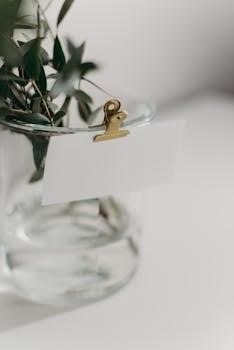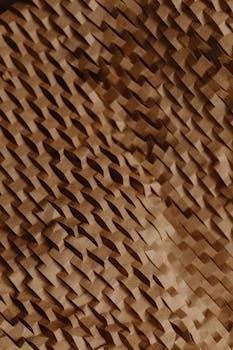Shapes in Nature Badge Overview
The Shapes in Nature badge encourages Girl Scouts to explore the natural world, identifying patterns and forms found within it. This STEM-focused badge helps them appreciate nature’s beauty through a mathematical lens.
Purpose of the Badge
The primary purpose of the Shapes in Nature badge is to cultivate an awareness of the mathematical principles inherent in the natural world. Girls will learn to recognize geometric shapes, symmetry, and patterns in various natural objects, from flowers and leaves to spiderwebs and honeycombs. This badge aims to connect abstract mathematical concepts to tangible, real-world examples. By engaging in hands-on activities and explorations, Girl Scouts develop critical thinking skills. They will improve their observation abilities, and foster a deeper appreciation for the intricate designs found in nature. Ultimately, the badge seeks to inspire girls to see the world around them with a new perspective, blending scientific inquiry with artistic appreciation.
Badge Requirements
Earning the Shapes in Nature badge involves completing specific activities tailored to each Girl Scout level. These requirements encourage exploration, observation, and creative expression through nature-based projects.
Daisy Level Requirements
For Daisies, the Shapes in Nature badge focuses on basic shape identification within natural settings. Girls will search for shapes like circles, squares, and triangles in flowers, leaves, and rainbows, fostering observation skills. They’ll find and create patterns using natural objects, enhancing their understanding of repeating designs in nature. Finally, Daisies will create art inspired by nature, expressing their creativity while reinforcing shape recognition. These activities encourage Daisies to appreciate nature’s beauty and learn basic geometric concepts through hands-on exploration and artistic expression. The requirements aim to make learning fun and engaging for this age group.
Brownie Level Requirements
Brownies explore shapes more deeply, tracking and graphing natural objects, enhancing data collection skills. They’ll count shapes in nature, identifying symmetry and tessellations in spiders, birds, and other natural objects. Brownies explore patterns, creating art inspired by nature’s tessellations. Activities involve exploring symmetry by making butterfly sculptures. They’ll investigate natural objects, focusing on counting, graphing, symmetry, and tessellations. Brownies will engage in activities that build on their observational and analytical skills, connecting mathematical concepts to the natural world. The requirements are designed to encourage scientific inquiry and creative expression, fostering a deeper understanding of mathematical principles in nature.
Junior Level Requirements
Juniors delve into more complex concepts like fractals and the Fibonacci sequence, expanding their understanding of mathematical patterns. They identify symmetry, create symmetrical art inspired by nature, and design mandalas. Juniors will find fractals, search for Fibonacci sequences, and identify patterns. The requirements include identifying symmetry in nature, making symmetrical art, creating mandalas, finding fractals, and searching for patterns. Juniors explore nature, using math to create their own designs. Juniors investigate patterns, symmetry, fractals, and the Fibonacci sequence. Through observation and analysis, Juniors connect mathematical principles to the beauty and complexity of the natural world.

Identifying Shapes in Nature
This section focuses on recognizing basic geometric shapes like circles, squares, triangles, and rectangles in natural objects. This helps develop observational skills and connects geometry to the real world.
Searching for Shapes
Embark on a scavenger hunt in nature, looking for various shapes hidden within plants, animals, and landscapes. This activity promotes careful observation and pattern recognition. Explore gardens, parks, or even your backyard, noting the shapes you discover. Consider leaves, flowers, spiderwebs, and even animal markings.
Document your findings through drawings, photographs, or a written list. Identify circles in flowers, squares in honeycombs, or triangles in leaves. Discuss how these shapes contribute to the object’s function or appearance. Encourage creativity in finding less obvious shapes. This hands-on exploration reveals the mathematical beauty present in the natural world around us.
Creating a Shapes Tally
After searching for shapes in nature, create a tally chart to organize your findings. This activity reinforces data collection and analysis skills. List different shapes, such as circles, squares, triangles, and spirals. As you review your collected data, mark each instance of a shape you observed in nature.
Analyze your tally chart to identify the most and least common shapes. Discuss potential reasons for these variations, considering environmental factors or the properties of natural objects. This activity fosters critical thinking and allows for comparison of shape distribution within a specific environment. Use your tally to create graphs!

Exploring Symmetry in Nature
Symmetry is all around us! This section explores how symmetry appears in the natural world. Discover bilateral and radial symmetry, observe examples, and learn to identify symmetrical patterns.
Bilateral Symmetry
Bilateral symmetry, a common pattern in nature, is when an object can be divided into two identical halves along a central line. Think of a butterfly with matching wings or a leaf with similar shapes on either side of its stem. Human faces also often display bilateral symmetry, though not perfectly.
Explore examples of bilateral symmetry in nature by observing animals, plants, and even landscapes. Identify the line of symmetry and consider how this pattern contributes to the object’s function or appearance. Understanding bilateral symmetry is crucial in art and design, reflecting nature’s influence.
Circular Symmetry
Circular symmetry, also known as radial symmetry, is a pattern where similar parts are arranged around a central point. Imagine a daisy with petals radiating from its center or a starfish with arms extending from a central disc. These are excellent examples of circular symmetry in nature.
Discover circular symmetry by observing flowers, fruits, and other natural objects. Notice how the arrangement around the center creates a balanced and visually appealing design. Understanding circular symmetry inspires art, such as mandalas, which use radial patterns to represent wholeness and harmony found in nature.

Fractals and the Fibonacci Sequence
Delve into the fascinating world of fractals, repeating patterns at different scales. Explore the Fibonacci sequence, a series of numbers evident in natural arrangements, revealing math’s inherent role in nature’s designs.
Finding Fractals
Fractals are repeating patterns found at different scales in nature. To find fractals, explore natural objects like ferns, snowflakes, or coastlines. Observe how the smaller parts resemble the whole. For instance, a small branch of a fern mirrors the shape of the entire fern frond.
Look closely at trees and rivers. Notice how a tree’s branches split into smaller branches, exhibiting a similar pattern. River systems often show fractal branching, where small tributaries join to form larger rivers.
Document your fractal discoveries through drawings or photographs. Consider creating a fractal collage using found natural materials. Sharing your findings with others can enhance their appreciation for nature’s mathematical beauty.
Fibonacci Sequence in Nature
The Fibonacci sequence is a series of numbers where each number is the sum of the two preceding ones (e.g., 1, 1, 2, 3, 5, 8). This sequence appears surprisingly often in nature. One example is the spiral arrangement of sunflower seeds. Count the spirals going in both directions; often, they correspond to consecutive Fibonacci numbers.
Pinecones also exhibit this spiral pattern. Examine pinecones and try to identify the Fibonacci numbers in their spiral arrangements. Another example is the branching of trees. The number of branches at each level can sometimes follow the Fibonacci sequence.
Explore flower petals. Many flowers have a number of petals that matches a Fibonacci number, such as lilies with three petals or buttercups with five.
Nature-Inspired Art
Create art using the shapes and patterns discovered in nature. This involves symmetrical designs found in butterflies or circular patterns found in flowers, using nature as the muse.
Symmetrical Art Projects
Engage in art projects that highlight symmetry observed in nature. Butterflies, leaves, and flowers are excellent subjects due to their inherent symmetrical qualities. Girls can create drawings, paintings, or collages that emphasize these symmetrical attributes, reinforcing their understanding of balance and mirroring in natural designs.
Consider using natural materials like pressed flowers or leaf rubbings to further connect the art to nature. The process can involve folding paper to create mirrored images, cutting out symmetrical shapes, or even designing symmetrical sculptures with found objects. This combines artistic expression with a deeper appreciation of symmetry.
Creating Mandalas
Mandalas offer a unique opportunity to explore circular symmetry and patterns found in nature. Constructing mandalas involves arranging natural items like pebbles, leaves, flowers, and seeds in a circular design emanating from a central point. This activity not only fosters creativity but also enhances understanding of radial symmetry.
Encourage girls to observe natural patterns as inspiration for their mandala designs. They can experiment with different arrangements and color combinations, reflecting the diverse beauty found in nature. This hands-on approach allows them to internalize the principles of symmetry while creating a visually appealing piece of art.

Connecting to STEM Careers
Exploring shapes in nature can spark interest in various STEM (Science, Technology, Engineering, and Mathematics) careers. Architects use geometric principles to design structures that are both functional and aesthetically pleasing, drawing inspiration from natural forms. Biologists study patterns in nature, such as the arrangement of leaves on a stem, to understand plant growth and adaptation.
Mathematicians develop models to describe and predict natural phenomena, relying on the understanding of shapes and patterns. Engineers use biomimicry, imitating nature’s designs to create innovative solutions to complex problems. Showing how nature connects to real-world careers can inspire future STEM leaders.

